Intel P965: Mid-Range Performance Sector Roundup
by Gary Key on October 20, 2006 9:00 PM EST- Posted in
- Motherboards
ASUS P5B-E: Board Layout and Features
After viewing the Abit AB9-Pro, the layout on the ASUS seems almost mundane. However, we have no real complaints about the layout except for the location of the IDE port and 24-pin ATX power connector. We feel like the IDE port connector should have been placed next to the floppy drive connector or replaced it. It would have been nice to have the 24-pin ATX connector located further to the right behind the memory slots. The motherboard was very easy to install and remove from our case. The four fan headers were within easy reach and can be controlled by the Q-Fan utility. The P5B-E replaces the P5B model. We tested both the 1.01G and 1.02G revision level boards and they are identical except for the BIOS changes and a PLL controller. Both boards feature an excellent three-phase voltage regulator power design along with high quality capacitors that yielded exceptional stability.
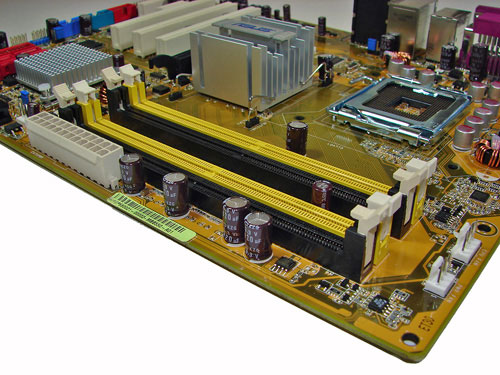
The DIMM module slots' color coordination is correct for dual channel setup based upon the premise of installing DIMMs in the same colored slots for dual-channel operation. The memory modules are slightly difficult to install with a full size video card placed in the PCI Express x16 slot. The 24-pin ATX power connector is located along the edge of the board along with a series of capacitors for the memory modules. We would have moved the 24-pin ATX connector to the upper right corner of the board to allow for easier access to the memory modules and CPU area in our case. It would also help to facilitate installation of PSUs with cables that are not longer than normal.
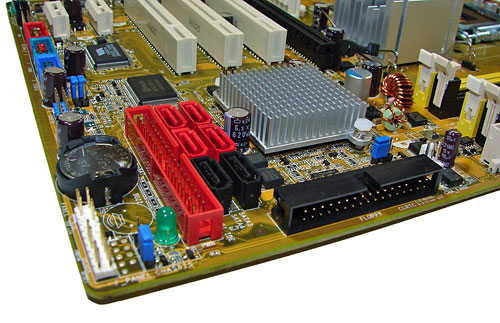
The four primary Intel ICH8R SATA ports are red along with the two secondary ports being black. These ports are conveniently located to the left of the ICH8R Southbridge and right of the battery and IDE port connector. We found the positioning of the SATA ports to be excellent when utilizing either the PCI-E x1 or PCI 2.3 slots. The ICH8R is passively cooled with a low rise heatsink and remained cool to the touch throughout testing.
The black floppy drive connector is located on the edge of the board and should have been switched with IDE port connector, as IDE cables are used far more than floppy cables these days. This switch would have eased installation of the IDE cable when using both the IDE and SATA ports. The clear CMOS jumper is color coded blue and is located in between the floppy drive connector and ICH8R chipset. This jumper was very difficult to use when utilizing a double slot video card. The chassis panel is located at the far left corner of the board.
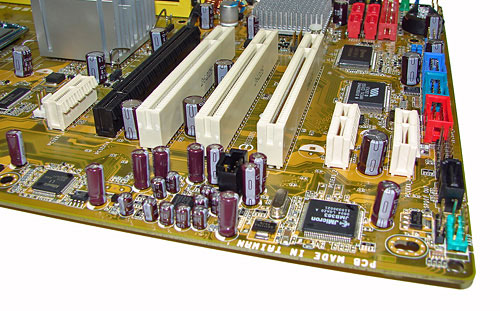
The board comes with (1) physical PCI Express x16 connector, (3) PCI Express x1 connectors, and (3) PCI 2.3 connectors. The layout of this design offers an excellent balance of expansion slots and provides very good clearance for most of the slots. When utilizing a double slot video card the first PCI slot is physically blocked and cannot be used. However, this still leaves two open PCI slots for use and all three PCI Express x1 slots. The black JMicron SATA port is on the right edge of the board along with the Firewire, COM1, and USB headers.
Returning to the CPU socket area, we find an ample amount of room for alternative cooling solutions that include most air and water cooling solutions. The Intel P965 MCH chipset is passively cooled with a mid-rise heatsink that did not interfere with any installed peripherals. This heatsinsk kept the MCH temperatures in check so that additional chipset voltage was not a factor in our overclocking tests. ASUS places the 4-pin ATX connector in the upper right section of the board and out of the way of the CPU area.
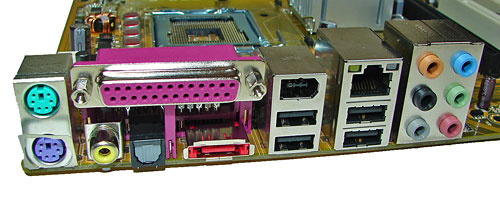
The rear panel contains the standard PS/2 mouse and keyboard, Parallel, LAN, and four USB 2.0 ports. The LAN (RJ-45) port has two LED indicators representing Activity and Speed of the connection through the Attansic L1 Gigabit PCI-E chipset. The audio panel consists of 6 ports that can be configured for 2, 4, 6, and 8-channel audio connections for the ADI 1988A HD codec. The panel also has two S/PDIF (optical out/coaxial out) ports, and an external SATA 3Gb/s port via the JMicron JMB383 chipset.
 |
| Click to enlarge |
After viewing the Abit AB9-Pro, the layout on the ASUS seems almost mundane. However, we have no real complaints about the layout except for the location of the IDE port and 24-pin ATX power connector. We feel like the IDE port connector should have been placed next to the floppy drive connector or replaced it. It would have been nice to have the 24-pin ATX connector located further to the right behind the memory slots. The motherboard was very easy to install and remove from our case. The four fan headers were within easy reach and can be controlled by the Q-Fan utility. The P5B-E replaces the P5B model. We tested both the 1.01G and 1.02G revision level boards and they are identical except for the BIOS changes and a PLL controller. Both boards feature an excellent three-phase voltage regulator power design along with high quality capacitors that yielded exceptional stability.

The DIMM module slots' color coordination is correct for dual channel setup based upon the premise of installing DIMMs in the same colored slots for dual-channel operation. The memory modules are slightly difficult to install with a full size video card placed in the PCI Express x16 slot. The 24-pin ATX power connector is located along the edge of the board along with a series of capacitors for the memory modules. We would have moved the 24-pin ATX connector to the upper right corner of the board to allow for easier access to the memory modules and CPU area in our case. It would also help to facilitate installation of PSUs with cables that are not longer than normal.

The four primary Intel ICH8R SATA ports are red along with the two secondary ports being black. These ports are conveniently located to the left of the ICH8R Southbridge and right of the battery and IDE port connector. We found the positioning of the SATA ports to be excellent when utilizing either the PCI-E x1 or PCI 2.3 slots. The ICH8R is passively cooled with a low rise heatsink and remained cool to the touch throughout testing.
The black floppy drive connector is located on the edge of the board and should have been switched with IDE port connector, as IDE cables are used far more than floppy cables these days. This switch would have eased installation of the IDE cable when using both the IDE and SATA ports. The clear CMOS jumper is color coded blue and is located in between the floppy drive connector and ICH8R chipset. This jumper was very difficult to use when utilizing a double slot video card. The chassis panel is located at the far left corner of the board.

The board comes with (1) physical PCI Express x16 connector, (3) PCI Express x1 connectors, and (3) PCI 2.3 connectors. The layout of this design offers an excellent balance of expansion slots and provides very good clearance for most of the slots. When utilizing a double slot video card the first PCI slot is physically blocked and cannot be used. However, this still leaves two open PCI slots for use and all three PCI Express x1 slots. The black JMicron SATA port is on the right edge of the board along with the Firewire, COM1, and USB headers.
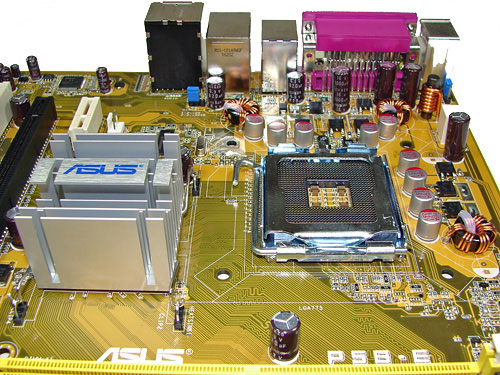 |
| Click to enlarge |
Returning to the CPU socket area, we find an ample amount of room for alternative cooling solutions that include most air and water cooling solutions. The Intel P965 MCH chipset is passively cooled with a mid-rise heatsink that did not interfere with any installed peripherals. This heatsinsk kept the MCH temperatures in check so that additional chipset voltage was not a factor in our overclocking tests. ASUS places the 4-pin ATX connector in the upper right section of the board and out of the way of the CPU area.

The rear panel contains the standard PS/2 mouse and keyboard, Parallel, LAN, and four USB 2.0 ports. The LAN (RJ-45) port has two LED indicators representing Activity and Speed of the connection through the Attansic L1 Gigabit PCI-E chipset. The audio panel consists of 6 ports that can be configured for 2, 4, 6, and 8-channel audio connections for the ADI 1988A HD codec. The panel also has two S/PDIF (optical out/coaxial out) ports, and an external SATA 3Gb/s port via the JMicron JMB383 chipset.










62 Comments
View All Comments
Gary Key - Saturday, October 21, 2006 - link
The DS4 will be reviewed. Gigabyte has stated they will not bring it into the US but we are still trying to convince them (really more like begging and calling our marketing rep at home on the weekends to beg some more) to release it in the States. The copper backplate can be removed off the DQ6 and I really did not see any benefit with it on in testing. It makes for a good rebate with the price of copper today. ;-)The AHCI issues stay the way they are at this time. It is frustrating to say the least. I was being a bit sarcastic in my statement but it is a little harder than it should be to enable AHCI on the ICH8R.
Ryan Norton - Sunday, October 22, 2006 - link
I'm in Taiwan, so the DS4 is all over the place :)Capt Caveman - Saturday, October 21, 2006 - link
Not sure if you live in the US or not but Gigabyte is not bringing/selling the DS4 to the US.Also, the copper backplate for the DQ-6, can be removed with a tworx(sp?) screwdriver. At XS, many just went to Home Depot and got longer screws for their HSF.
lopri - Saturday, October 21, 2006 - link
Excellent review that'll help potential buyers enormously. A couple things:1. Error in the chart (page 14): There is a discrepency between the chart (3-4-3) and the commentary (3-4-4) :)
2. In memory review Wesley always put tRP ahead of tRCD, while Gary does the opposite. It'd be nice to have a consistency for less experienced users!
3. Gary, did you test the P5W-DH with wirless module installed or without? I recently found out the wirless module could skew CPU/memory-sensitive benchmarks on this board big time. I'm not sure if my finding is true in general, but if it is, then the comparison between a board with such feature and a board without it can be unfair.
4. Can Sandra Unbuffered be really an indication of general performace? @400FSB, setting memory ratio 4:5 (DDR2-1000/4-4-3) boosted the score by a whooping 400~500 MB/s from the ratio 1:1 (DDR2-800/3-3-3), which never realized for other tests in a meaningful way. Oh this is about my own testing. :D
Thanks for the great review.
Gary Key - Saturday, October 21, 2006 - link
Thanks for the comments.1. The timing error is corrected. Jarred and I were editing at the same and we found out after the article went live that our saves to the final copy would overwrite each other. Bad timing for several other mistakes that have been cleared up now.
2. Wes is wrong. Just kidding, we will get on the same page. :)
3. I turned off the WiFi on the PSW-DH. The scores were even worse with it on. Not that they are bad but the board runs a little looser timings in order to overclock at the high end. DFI also does this with their boards targeted for the overclocking market.
4. Sandra Unbuffered can be an indication of performance in apps that are memory sensitive. This is not always the case but it is one of the better yardsticks available at this time.
Lothar - Saturday, October 21, 2006 - link
Do you plan on comparing the Gigabyte DS3 vs the S3 version for us to know if there are performance/overclocking issues with the S3?The only difference so far between the DS3 and S3 is "All Solid Capacitors".
Are there any other difference I'm missing?
The S3 is $110, and the DS3 is $150.
I have a hard time to justify paying an extra $40 for only "all solid capacitors"
The term is nothing but marketing to me so far.
I haven't seen any proof of a performance/overclocking issue between the two boards.
If you or anyone else plan on testing the differences or can provide something(Ex: any review link) stating otherwise, that would be great.
Nakazato - Monday, October 23, 2006 - link
In theory, cleaner power.... but aside from the theory, the onboard sound does start flaking out the higher you go. This has been true on 2/2 boards I've tried it on. So an add-in card is needed for the higher overclocks... 460+ish.goinginstyle - Monday, October 23, 2006 - link
No issue here with the Biostar board at 500FSB and the Realtek ALC-883. It sounds fine but a X-FI is still the way to go for gaming.Gary Key - Saturday, October 21, 2006 - link
Yes, the S3 will be in part two. :)
Lothar - Saturday, October 21, 2006 - link
The only other differences I found were RAID support and 2 extra USB ports...It's not worth the $40 price difference if performance and overclocking results are the same IMO.